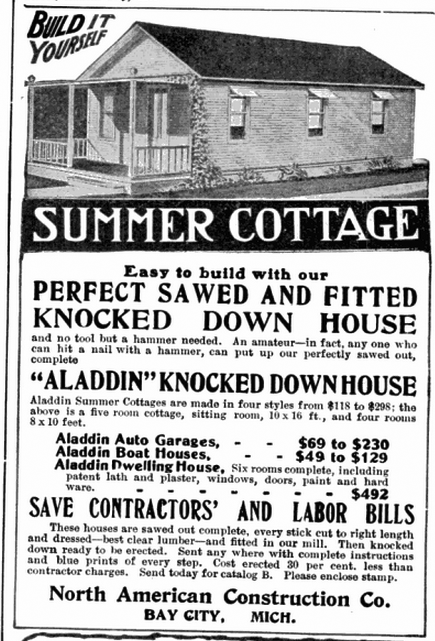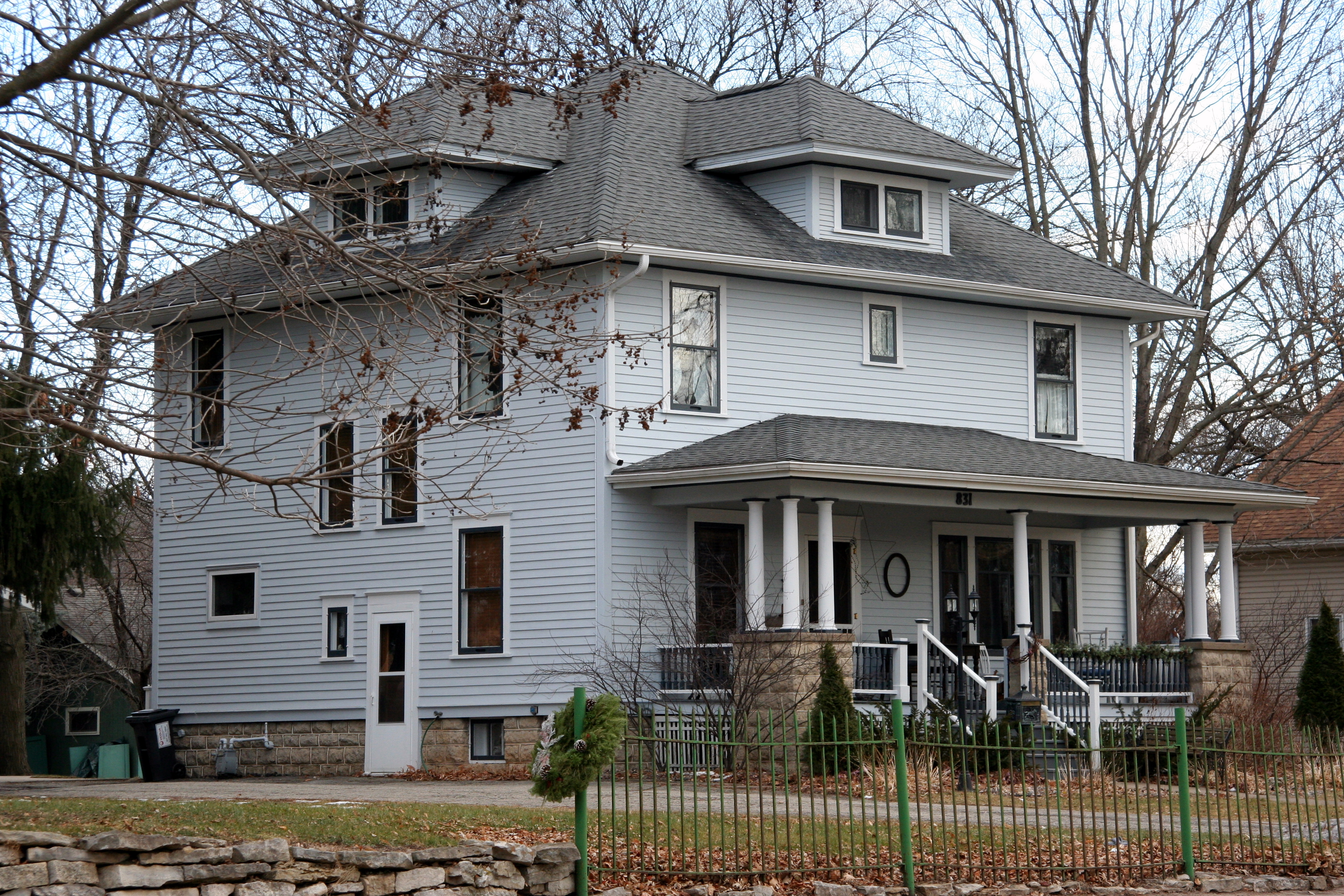|
The Aladdin Company
The Aladdin Company was a pioneer in the pre-cut, mail order home industry. Sometimes referred to as Aladdin Readi-Cut Houses, the company was the first to offer a true kit house composed of precut, numbered pieces. Its primary competitors were Montgomery Ward and Sears, Roebuck and Co. in the US and Eaton's in Canada. Two other kit home manufacturers, Lewis and Sterling, were also based in Bay City. Aladdin began operations in 1906 and ceased operations in 1987. In 2014 the rights to the company name and logo were acquired by Charles Munro and sold in 2018 History Origins Aladdin was founded by two brothers, W. J. Sovereign and O. E. Sovereign in Bay City, Michigan, after W. J. observed the success of the Brooks Boat Mfg. Co. in selling knock-down boats. The company began by selling boat houses, garages and summer cottages. Almost immediately the company was also involved in the Canadian market, and eventually opened a branch office in the prestigious Canadian Pacific ... [...More Info...] [...Related Items...] OR: [Wikipedia] [Google] [Baidu] |
Kit Houses In North America
Kit houses, also known as mill-cut houses, pre-cut houses, ready-cut houses, mail order homes, or catalog homes, were a type of prefabricated housing that was popular in the United States, Canada, and elsewhere in the first half of the 20th century. Kit house manufacturers sold houses in many different plans and styles, from simple bungalows to imposing Colonials, and supplied at a fixed price all materials needed for construction of a particular house, but typically excluding brick, concrete, or masonry (such as would be needed for laying a foundation, which the customer would have to arrange to have done locally). Some house styles, like log cabins and geodesic dome homes, are still sometimes sold in kit form. Design Stick-built, balloon-framed kit houses were built as permanent, not temporary structures, as the manager of the Sears, Roebuck lumber department explained to a United States Senate committee in 1919: A ready-cut house should not be confused with a sectional-por ... [...More Info...] [...Related Items...] OR: [Wikipedia] [Google] [Baidu] |
Austin Village
Austin Village is a First World War housing estate of prefabs between Longbridge and Northfield, Birmingham. Herbert Austin, who created the Austin Motor Company at Longbridge in 1905, had to take on more workers during the First World War when his factory became involved in making tanks and aircraft. In 1917, he built a new estate for his employees in Turves Green on land bought for £7,750.''Birmingham - The Building of a City'', Joseph McKenna, Tempus Publishing Ltd. 2005, He imported 200 red cedar wood pre-fabricated bungalows from the Aladdin Company, Bay City, Michigan, USA. They were shipped across the Atlantic and survived potential loss by U-boat attack. These were erected with twenty-five conventional brick-built semi-detached houses at intervals to create firebreaks. They were fitted with coke-fired central heating, gas cooker, gas water boiler, sink and drainer, and a bathroom with bath.''The Austin Village'', Austin Village Preservation Society, 2002, The ext ... [...More Info...] [...Related Items...] OR: [Wikipedia] [Google] [Baidu] |
Kit House
Kit houses, also known as mill-cut houses, pre-cut houses, ready-cut houses, mail order homes, or catalog homes, were a type of prefabricated housing that was popular in the United States, Canada, and elsewhere in the first half of the 20th century. Kit house manufacturers sold houses in many different plans and styles, from simple bungalows to imposing Colonials, and supplied at a fixed price all materials needed for construction of a particular house, but typically excluding brick, concrete, or masonry (such as would be needed for laying a foundation, which the customer would have to arrange to have done locally). Some house styles, like log cabins and geodesic dome homes, are still sometimes sold in kit form. Design Stick-built, balloon-framed kit houses were built as permanent, not temporary structures, as the manager of the Sears, Roebuck lumber department explained to a United States Senate committee in 1919: A ready-cut house should not be confused with a sectional-p ... [...More Info...] [...Related Items...] OR: [Wikipedia] [Google] [Baidu] |
Cape Cod (house)
A Cape Cod house is a low, broad, single or double-story frame building with a moderately-steep-pitched gabled roof, a large central chimney, and very little ornamentation. Originating in New England in the 17th century, the simple symmetrical design was constructed of local materials to withstand the stormy weather of Cape Cod. It features a central front door flanked by multipaned windows. The space above the first floor was often left as unfinished attic space, with or without windows on the gable ends. The building type enjoyed a boom in popularity and adaptation to modern needs in the 1930s–1950s, particularly with Colonial Revival embellishments. It remains a feature of New England homebuilding. History The Cape Cod cottage–type house (it is a form or type, not a style, though commonly--mistakenly--referred to as a style) originated in the wood-building counties of England and was brought to America by Puritan carpenters. The harsh climate of New England tested the ... [...More Info...] [...Related Items...] OR: [Wikipedia] [Google] [Baidu] |
Foursquare House
The American Foursquare or American Four Square is an American house style popular from the mid-1890s to the late 1930s. A reaction to the ornate and mass-produced elements of the Victorian and other Revival styles popular throughout the last half of the 19th century, the American Foursquare was plain, often incorporating handcrafted "honest" woodwork (unless purchased from a mail-order catalog). This style incorporates elements of the Prairie School and the Craftsman styles. It is also sometimes called Transitional Period. The hallmarks of the style include a basically square, boxy design, two-and-one-half stories high, usually with four large, boxy rooms to a floor (with the exception of the attic floor, which typically has only one or two rooms), a center dormer, and a large front porch with wide stairs. The boxy shape provides a maximum amount of interior room space, to use a small city lot to best advantage. Other common features included a hipped roof, arched entries bet ... [...More Info...] [...Related Items...] OR: [Wikipedia] [Google] [Baidu] |
Bungalow
A bungalow is a small house or cottage that is either single-story or has a second story built into a sloping roof (usually with dormer windows), and may be surrounded by wide verandas. The first house in England that was classified as a bungalow was built in 1869. In America it was initially used as a vacation architecture, and was most popular between 1900 and 1918, especially with the Arts and Crafts movement. The term bungalow is derived from the word and used elliptically to mean "a house in the Bengal style." Design considerations Bungalows are very convenient for the homeowner in that all living areas are on a single-story and there are no stairs between living areas. A bungalow is well suited to persons with impaired mobility, such as the elderly or those in wheelchairs. Neighborhoods of only bungalows offer more privacy than similar neighborhoods with two-story houses. As bungalows are one or one and a half stories, strategically planted trees and shrubs ... [...More Info...] [...Related Items...] OR: [Wikipedia] [Google] [Baidu] |
Craftsman House
American Craftsman is an American domestic architectural style, inspired by the Arts and Crafts movement, which included interior design, landscape design, applied arts, and decorative arts, beginning in the last years of the 19th century. Its immediate ancestors in American architecture are the Shingle style architecture, Shingle style, which began the move away from Victorian ornamentation toward simpler forms; and the Prairie style of Frank Lloyd Wright. The name "Craftsman" was appropriated from furniture-maker Gustav Stickley, whose magazine ''The Craftsman'' was first published in 1901. The architectural style was most widely used in small-to-medium-sized Southern California single-family homes from about 1905, so that the smaller-scale Craftsman style became known alternatively as " California bungalow". The style remained popular into the 1930s, and has continued with revival and restoration projects through present times. Influences The American Craftsman style was a ... [...More Info...] [...Related Items...] OR: [Wikipedia] [Google] [Baidu] |
Architectural Style
An architectural style is a set of characteristics and features that make a building or other structure notable or historically identifiable. It is a sub-class of style in the visual arts generally, and most styles in architecture relate closely to a wider contemporary artistic style. A style may include such elements as form, method of construction, building materials, and regional character. Most architecture can be classified within a chronology of styles which changes over time, reflecting changing fashions, beliefs and religions, or the emergence of new ideas, technology, or materials which make new styles possible. Styles therefore emerge from the history of a society. They are documented in the subject of architectural history. At any time several styles may be fashionable, and when a style changes it usually does so gradually, as architects learn and adapt to new ideas. The new style is sometimes only a rebellion against an existing style, such as post-modernism (meaning ... [...More Info...] [...Related Items...] OR: [Wikipedia] [Google] [Baidu] |
Prefabrication
Prefabrication is the practice of assembling components of a structure in a factory or other manufacturing site, and transporting complete assemblies or sub-assemblies to the construction site where the structure is to be located. The term is used to distinguish this process from the more conventional construction practice of transporting the basic materials to the construction site where all assembly is carried out. The term ''prefabrication'' also applies to the manufacturing of things other than structures at a fixed site. It is frequently used when fabrication of a section of a machine or any movable structure is shifted from the main manufacturing site to another location, and the section is supplied assembled and ready to fit. It is not generally used to refer to electrical or electronic components of a machine, or mechanical parts such as pumps, gearboxes and compressors which are usually supplied as separate items, but to sections of the body of the machine which in the ... [...More Info...] [...Related Items...] OR: [Wikipedia] [Google] [Baidu] |
World War II
World War II or the Second World War, often abbreviated as WWII or WW2, was a world war that lasted from 1939 to 1945. It involved the vast majority of the world's countries—including all of the great powers—forming two opposing military alliances: the Allies and the Axis powers. World War II was a total war that directly involved more than 100 million personnel from more than 30 countries. The major participants in the war threw their entire economic, industrial, and scientific capabilities behind the war effort, blurring the distinction between civilian and military resources. Aircraft played a major role in the conflict, enabling the strategic bombing of population centres and deploying the only two nuclear weapons ever used in war. World War II was by far the deadliest conflict in human history; it resulted in 70 to 85 million fatalities, mostly among civilians. Tens of millions died due to genocides (including the Holocaust), starvation, ma ... [...More Info...] [...Related Items...] OR: [Wikipedia] [Google] [Baidu] |
Great Depression
The Great Depression (19291939) was an economic shock that impacted most countries across the world. It was a period of economic depression that became evident after a major fall in stock prices in the United States. The economic contagion began around September and led to the Wall Street stock market crash of October 24 (Black Thursday). It was the longest, deepest, and most widespread depression of the 20th century. Between 1929 and 1932, worldwide gross domestic product (GDP) fell by an estimated 15%. By comparison, worldwide GDP fell by less than 1% from 2008 to 2009 during the Great Recession. Some economies started to recover by the mid-1930s. However, in many countries, the negative effects of the Great Depression lasted until the beginning of World War II. Devastating effects were seen in both rich and poor countries with falling personal income, prices, tax revenues, and profits. International trade fell by more than 50%, unemployment in the U.S. rose to 23% and ... [...More Info...] [...Related Items...] OR: [Wikipedia] [Google] [Baidu] |
Florida Land Boom Of The 1920s
The Florida land boom of the 1920s was Florida's first real estate bubble. This pioneering era of Florida land speculation lasted from 1924 to 1926 and attracted investors from all over the nation. The land boom left behind entirely new, planned developments incorporated into towns and cities. Major investors and speculators such as Carl G. Fisher also left behind a new history of racially deed restricted properties that segregated cities for decades. Among those cities at the center of this bubble were Miami Beach, Coral Gables, Hialeah, Miami Springs, Opa-locka, Miami Shores, and Hollywood. It also left behind the remains of failed development projects such as Aladdin City in south Miami-Dade County, Fulford-by-the-Sea in what is now North Miami Beach, Miami's Isola di Lolando in north Biscayne Bay, Boca Raton, as it had originally been planned, Okeelanta in western Palm Beach County, and Palm Beach Ocean just north of the Town of Palm Beach. The land boom shaped Florida ... [...More Info...] [...Related Items...] OR: [Wikipedia] [Google] [Baidu] |






.jpg)




